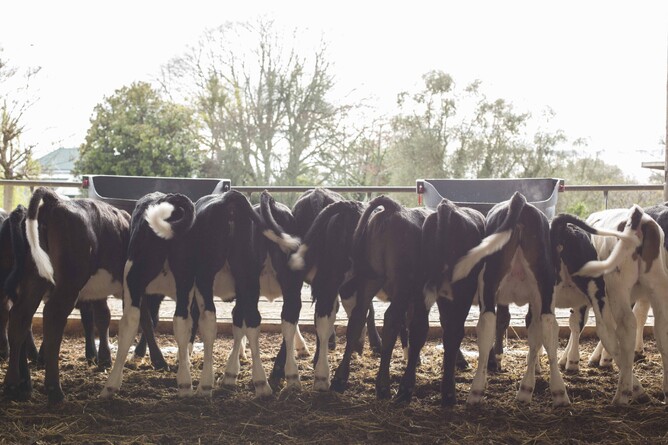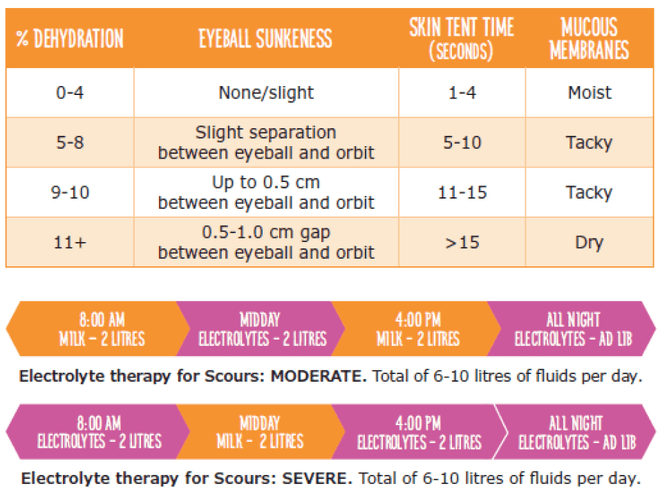Each season, we see outbreaks of scours in calf sheds. In some cases, the setup of the shed exacerbates the problem, with inadequate systems in place to separate sick mobs from healthy ones. Some calves may also not have access to water, which prevents the dehydrated calves from being able to self-medicate.
With cases of down calves and scouring, we will collect samples to confirm the cause, which is often rotavirus or Crytosporidium. Once we have identified the root of the problem, we will stomach tube any down calves with warm electrolytes and help the calf rearer to practice until they are confident to take over.
Ultimately, calf scours can be very difficult to manage. Once it starts, it often spirals downward as it's very contagious and hard to eradicate the bugs once they have started multiplying.
Avoiding calf scours in the first place is much easier than stemming an outbreak, which can be very frustrating as the viruses causing it are very 'sticky' and hard to clean away, plus easy to transfer between pens on boots, calves and feeders.
Prevention
Hygiene, environment, and colostrum are all important factors in prevention.
Not all calf sheds are made equal, or even purpose made. The ideal shed is north facing or facing away from the prevalent wind, with solid sides and fences up to 1-1.5m high, depending on bedding depth, to reduce the wind to nothing at floor level. Air circulation in the shed is important as sheds shut up tight can have high ammonia levels from urine, which irritate the nose and lungs and can lead to pneumonia.
Getting the floor right to promote drainage is also important, to help keep the bedding dry. You can also spray out the whole shed with a virus-killing treatment, such as Vetsan or Sterigene, prior to putting fresh bedding on and before any calves are in the shed.
Solid walls in the shed, or at least between the sick pen and other pens, can help improve the ease of cleaning out one area, and reduce spread of disease between pens.
Visitors to the calf sheds should also be avoided, or else they should be encouraged to use a disinfectant foot bath, and perhaps have gumboots only for the calf shed.
Colostrum is essential early in a calf's life as their stomach lining reduces how well it absorbs antibodies within hours of birth to not at all at 12 hours after birth. Getting calves out of the cold weather and some colostrum into their stomach early can require an extra staff member, but can make everyone else's jobs easier in the long run.
The amount of antibodies in cows’ colostrum can be increased both by using "gold" colostrum, and by injecting cows with a vaccination such as Rotavec Corona vaccine, 3 -12 weeks before they calve, to increase the protection a calf gets against some of the common causes of calf scours.
Treatments available:
Replacing fluid loss is usually done with electrolytes such as Revive. Protocols have changed over the years, but studies have shown continuing some milk feeds while giving electrolytes, rather than stopping them completely, is more beneficial to the calves, as they lose less weight and recover quicker. The table below helps give some sample treatment protocols:
At over 8% dehydration, intravenous fluids can be more beneficial - Call your vet if you have a valuable calf you would like IV fluids for.
Anti-inflammatories such as Metacam have been shown to reduce pain and improve drinking and recovery in calves with scours. Antibiotics do not necessarily help, but we do recommend them if the calf’s temperature is elevated (over 39.5°C).
Testing for the cause of diarrhoea - preferably with 3-4 samples as some viruses do not test positive in every case - can be helpful in determining other treatments that may be useful. Talk to a vet about your situation, and they may recommend Halocur, or Kryptade for cryptospirosis, or Rotagen for rotavirus.
If you had any problems last year and wish to discuss if there any preventative measures you can put in place now, or if you are starting to have an issue with scours in your calves, give us a call.


